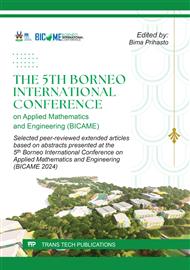[1]
N. Sasria, R.T. Jayanti, N.R.M. Aras, M.A. Fitrah, Y. Malik, H.H. Utami, A.P. Putra, F.D.I. Sawali, Mustofa, I. Siregar, M.A. Albar, Pengetahuan bahan, CV. Mitra Mandiri Persada – Surabaya, 2023, p.164.
Google Scholar
[2]
N. Sasria, V.N. Afifah, G.U.N. Tajalla: submitted to Makara Journal of Science (2023).
Google Scholar
[3]
Zaenab, N. Sasria, M.P.D. Lubis, Pengaruh carboxymethyl cellulose terhadap sifat bioplastik berbasis tandan kosong kelapa sawit dan plasticizer gliseroL, Alchemy: Journal of Chemistry. 11 (2023) 25-31.
DOI: 10.18860/al.v11i2.20389
Google Scholar
[4]
Y. Darni, T.M. Sitorus, M. Hanif, Thermoplastic processing of sorghum and cellulose to produce bioplastics, Jurnal Rekayasa Kimia dan Lingkungan. 10 (2014) 55–62.
DOI: 10.23955/rkl.v10i2.2420
Google Scholar
[5]
H. Zhuang, M.M. Barth, L. Cisneros-Zevallos, Modified atmosphere packaging for fresh fruits and vegetables, in: Innovations in Food Packaging: second ed., Elsevier Ltd., 2013, p.445–473.
DOI: 10.1016/b978-0-12-394601-0.00018-7
Google Scholar
[6]
A. Alfiani, N. Sasria, M.P.D. Lubis, Pengaruh carboxymethyl celullose terhadap karakteristik bioplastik menggunakan tandan kosong kelapa sawit dan pati ampas tahu, Jurnal Integrasi Proses. 12 (2023) 12-16.
DOI: 10.36055/jip.v12i1.18932
Google Scholar
[7]
Z. Zhang, O. Ortiz, R. Goyal, J. Kohn, Biodegradable polymers, in: Handbook of Polymer Applications in Medicine and Medical Devices, Elsevier Inc., 2014, p.303–335.
DOI: 10.1016/b978-0-323-22805-3.00013-x
Google Scholar
[8]
N. Sasria, Meliana, Y. Triana, A.W.Y.P. Parmita: submitted to the 8th International Conference and Exhibition on Sustainable Energy and Advanced Materials (ICE-SEAM) (2022).
Google Scholar
[9]
N. Sasria, V.N. Afifah, A. Alfiani, M.P.D. Lubis, G.U.N. Tajalla, Pengaruh jenis pati dan variasi komposisi plasticizer terhadap karakteristik bioplastik berbasis selulosa dari tandan kosong kelapa sawit (TKKS), PT. Nasya Expanding Management – Pekalongan, 2024, p.84.
DOI: 10.36055/jip.v12i1.18932
Google Scholar
[10]
H. Abral, A. Basri, F. Muhammad, Y. Fernando, F. Hafizulhaq, M. Mahardika, E. Sugiarti, S.M. Sapuan, R.A. Ilyas, I. Stephane, A simple method for improving the properties of the sago starch films prepared by using ultrasonication treatment, Food Hydrocolloids. 93 (2019) 276–283.
DOI: 10.1016/j.foodhyd.2019.02.012
Google Scholar
[11]
N. Sasria, O. Tang, H.A. Dewanto: submitted to International and National Seminar on Materials and Metallurgical Engineering in Borneo (2023).
Google Scholar
[12]
B. Thapa, R. Narain, Mechanism, current challenges and new approaches for nonviral gene delivery, in: Polymers and Nanomaterials for Gene Therapy, Elsevier Ltd., 2016.
DOI: 10.1016/b978-0-08-100520-0.00001-1
Google Scholar
[13]
E.O. Ningrum, L. Ardiani, N.A. Rohmah, N. Fajar, Modifikasi biokomposit kitosan dari cangkang rajungan (portunus pelagicus) dan pektin untuk aplikasi edible film, Prosiding Seminar Nasional Teknik Kimia" Kejuangan". (2019) 1-6.
DOI: 10.20473/jbp.v18i2.2016.98-111
Google Scholar
[14]
C.S. Joseph, K.V.H. Prashanth, N.K. Rastogi, A.R. Indiramma, S.Y. Reddy, K.S.M.S. Raghavarao, Optimum blend of chitosan and poly-(ε-caprolactone) for fabrication of films for food packaging applications, Food and Bioprocess Technology. 4 (2011) 1179–1185.
DOI: 10.1007/s11947-009-0203-1
Google Scholar
[15]
K.C. Yustisi, K. Wulandari, I. Utami, Pembuatan plastik biodegradable berbahan pati dari limbah kulit pisang raja dengan penambahan kitosan dan plasticizer sorbitol, Inovasi Teknik Kimia. 9 (2024) 31-36.
DOI: 10.31942/inteka.v3i2.2488
Google Scholar
[16]
S. Solekah, N. Sasria, H.A. Dewanto, Pengaruh penambahan gliserol dan kitosan kulit udang terhadap biodegradasi dan ketahanan air plastik biodegradable, al-Kimiya: Jurnal Ilmu Kimia dan Terapan. 8 (2021) 80-86.
DOI: 10.15575/ak.v8i2.13917
Google Scholar
[17]
N. Sasria, R. Hernando, M.P.D. Lubis, A. Zulfikar, Production of biodegradable plastics using aking rice starch and chitosan from crab shells as a substitute for conventional plastic, IOP Conf. Series: Materials Science and Engineering. 1053 (2021) 1-9.
DOI: 10.1088/1757-899x/1053/1/012079
Google Scholar
[18]
A.D. Oktavia, N. Idiawati, D. Lia, Studi awal pemisahan amilosa dan amilopektin pati ubi jalar (Ipomoea batatas Lam), Jurnal Kimia. 2 (2013) 153–156.
Google Scholar
[19]
S. Diana, R. Fikri, Karakterisasi bioplastik dari pati kulit singkong dengan penambahan kitosan, Jurnal Teknologi. 14 (2014) 53-57.
Google Scholar
[20]
W. Saputra, A. Hartiati, B.A. Harsojuwono, Pengaruh konsentrasi seng oksida (ZnO) dan penambahan gliserol terhadap karakteristik bioplastik dari pati umbi gadung (Dioscorea hispida Deenst), Jurnal Rekayasa dan Manajemen Agroindustri. 7 (2019) 531.
DOI: 10.24843/jrma.2019.v07.i04.p05
Google Scholar
[21]
T. Muharam, D. Fitriani, D.F.M. Jannah, M.Z.A. Ghifari, R.P. Sihombing, Karakteristik daya serap air dan biodegradabilitas pada bioplastik berbasis pati singkong dengan penambahan polyvinyl alcohol, Prosiding Seminar Nasional Aplikasi Sains & Teknologi (SNAST). (2022) 35-49.
DOI: 10.34151/prosidingsnast.v8i1.4152
Google Scholar
[22]
Japanese Industrial Standard (JIS) 2-1707, Japanese standards association, Japan, 1975.
Google Scholar
[23]
S. Hidayat, R.F. Septiyanto, A.H.D. Abdullah, Y.R.D. Muchtar, I. Affifah, Perbandingan sifat mekanik bioplastik terhadap penambahan zinc oxide (ZnO), Gravity: Jurnal Ilmiah Penelitian dan Pembelajaran Fisika. 5 (2019) 8-12.
DOI: 10.30870/gravity.v5i2.5939
Google Scholar
[24]
F. Takribiah, Harunsyah, Z. Amalia, R. Fauzan, M. Sami, Pembuatan bioplastik dengan penguat ZnO dan penambahan minyak atsiri sebagai anti mikroba, Jurnal Teknologi. 22 (2022) 37-43.
DOI: 10.30811/teknologi.v22i1.2881
Google Scholar
[25]
M.R. Utami, N. Widiarti, Sintesis plastik biodegradable dari kulit pisang dengan penambahan kitosan dan plasticizer gliserol, Indonesian Journal of Chemical Science. 3 (2014) 163-167.
DOI: 10.35472/jsat.v4i1.205
Google Scholar
[26]
T. Surdia, S. Saito, Pengetahuan bahan teknik, PT. Pradnya Paramita – Jakarta, 1999, p.173.
Google Scholar
[27]
N. Sasria, Asrilsyah, M.P.D. Lubis, A. Zulfikar, R.A. Tanjung, Sintesis dan karakterisasi plastik biodegradable berbasis pati nasi aking dan kitosan cangkang udang, Teknika: Jurnal Sains dan Teknologi. 16 (2020) 231-236.
DOI: 10.36055/tjst.v16i2.8700
Google Scholar



